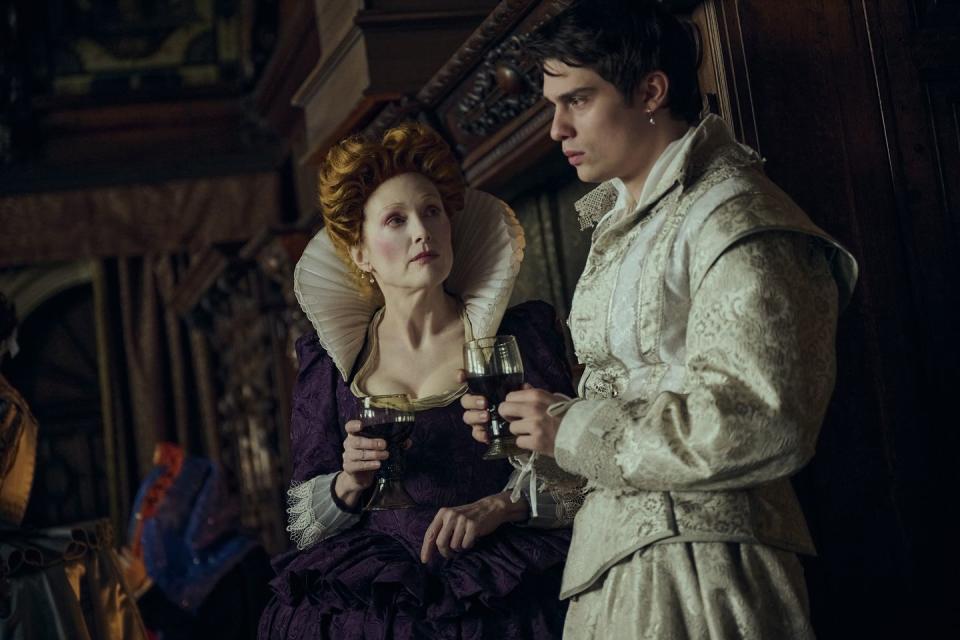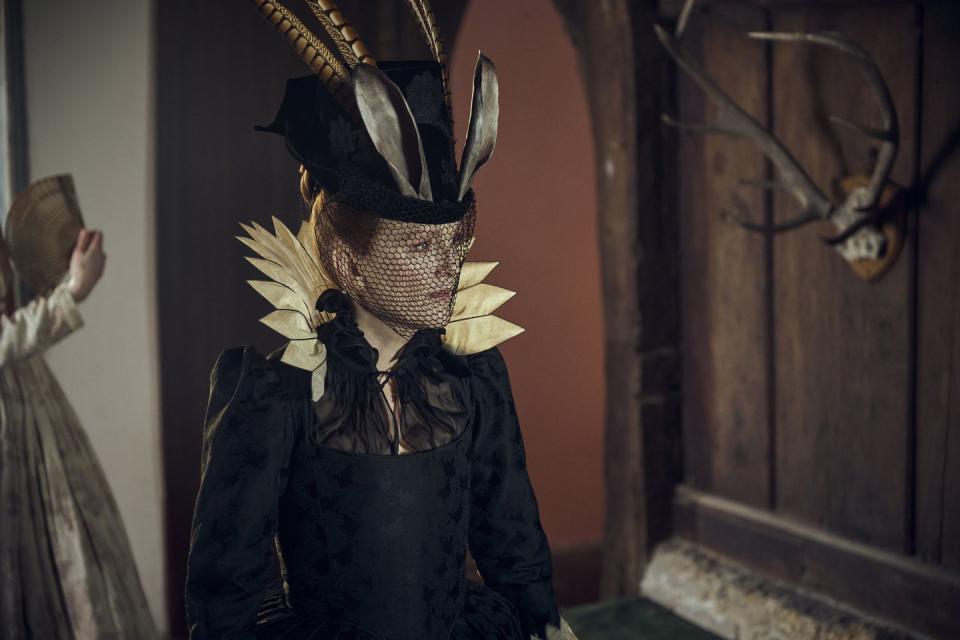If you’re not familiar with Jacobean clothing, it’s time to take note. As costume designer Annie Symons explains to us while discussing her work on the new miniseries Mary & George (available now on Now TV), the era – in which James I ruled jointly over both England and Scotland from 1603 to 1625 – is not often represented in film or television, but is filled with sartorial joy. The hats, the ruffles, the jewels and the fabrics: this was the moment when English court fashion was at its most flamboyant.
So flamboyant in fact that the fashion in Mary & George essentially has its own character. Based on Benjamin Woolley’s 2017 history book The King’s Assassin, the series follows mother Mary (played by Julianne Moore) and son George Villiers (Nicholas Galitzine) as they rise through the ranks of James’ court, with George ultimately becoming the king and his personal favorite . In this story, dressing the role literally becomes a matter of life and death.
Mary & George is a psychosexual court drama full of intrigue and strange undertones, and Symons’ costumes provide just the right amount of camp. We spoke to the costume designer to find out more about the color Julianne Moore asked not to wear, and how maybe – just maybe – collars are making their way back into fashion.
I imagine it is difficult to find new ways to make historical pieces look different. How did you achieve that with Mary & George?
“Well, that’s the thing: we haven’t seen this period before, because it’s rarely done. We’ve seen many Jacobean tragedies on stage in Britain, but very few in television performances, so it was exciting to explore new territory. James was only on the throne for a short time, but he truly defined a style and fashion that is unique. There was nothing available in terms of costumes at the rental houses, so we had to make everything. We [rented] a little bit of Elizabethan stock.


How does the Jacobean costume differ from the Elizabethan costume?
“The shapes are different. Jacobean is all about these falling collars, the jewelry, the hairstyles. The Elizabethan period had these huge farthingales [underneath skirts to give them their shape]but in the Jacobean style everything begins to become softer and more wearable.”
This show is, in a very simple sense, all about social climbing. How did you communicate that through the clothing?
“Mary uses costume as a tool. Clothes and fabrics are signals of power, wealth and status, just as they are today; but then it was even more important, because you really had to fake it to make it, to get to court. It is known that several families of that seventeenth-century period went bankrupt in their attempt to become part of a world that could afford the clothes and phenomenally expensive lace that came into fashion.”
How did you bring Julianne Moore’s character, Mary, to life through costumes?
“Mary uses costume as a chameleon’s calling card. Wherever she goes, she seems to fit in – except for one scene, in which she consciously wears a purple farthingale dress with ‘prostitute makeup’. But that was very conscious, and she wears that to consciously draw attention to herself. But when the show begins, Mary is quite exhausted: her resources have been drained and her family is living in this medieval house under limited circumstances. Their clothes are of good quality, but I took out all the colors. We used a lot of dried out bones, lichens and dried blood to suggest that something had withered and died. As she progresses, she is encouraged, and as she becomes richer, as she marries for money, she uses that money to dress herself and her son George to play the tailor’s game.


How do we see her costumes change as she climbs the social ladder and her character develops?
“In fact, every time there was an important moment with Mary, she had an outfit in a different color. She is like a chess piece that changes color. The most important thing was to get shapes and a look that really complemented Julianne. I first met her in Savannah while she was filming May December. I flew out with five suitcases of stuff that was available – hip rolls, waist rolls, farthingales, God knows what else – and we spent a whole day trying out different shapes and figuring out what suited her.
“What I ended up doing was leaning a bit on Dior’s New Look. The Jacobean waist rises, but it’s not as flattering on camera, so I kept her costumes at a natural waist. Mary’s character is very precise and neat. Like a rocket, she is determined to achieve her goals. And we also had the idea that she was a modern woman living in a man’s world. There are elements of her that are quite appropriate and masculine in their simplicity. For example, when she’s in London she wears a sort of proto-feminist leather jacket which I thought looked quite funky and was appropriate for London.”
That’s so interesting that you were inspired by the new look for a Jacobean costume.
“What we ended up with is akin to the New Look, which came later, and also to the Elizabethan look, which came earlier. Waistlines in the Jacobean period crept higher and higher – but that meant a lot of bulk for the camera. We also felt that Julianne’s portrayal of Maria should remain quite sharp. I took from the past and learned from the future.”
What is it like to dress up Julianne Moore? Did she cooperate, or let you roam free?
“Julianne has a lot of confidence. It’s all about how she feels in the costume, which I completely understand. She wore a corset mainly to support the weight of these rather large skirts. For her character, I kept saying, “Another costume!” Because she ended up with about 65 costumes. She’d say, “You’re the designer, so if you like it, I like it!” Then I asked if she was feeling okay, and she said yes. However, there was one color she didn’t want to wear…


And what color was that?
“Trade secret! It was yellow. I wanted to make her emerge like a sun from a sky-blue court. But I didn’t want to bring the matter to a head.”
Yellow is a cool color!
“It’s real! It’s all about the skin color. But you can’t blame me for trying.”
There are some really fantastic hats in this show.
“I was very happy that Julianne embraced the hats, because they are part of the outfits. Hats can be difficult – you have to work very closely with the hair people, especially when it comes to period things. The hair supports the hat. We tried many shapes and finally settled on a variation that we thought worked. The most special thing Julianne wears is the one with these giant bunny ears. The director said: ‘Just go for it’.”
Sex plays a very important role in the plot of this show. How did you make the Jacobean dress sexy?
“We used a lot of gauzy fabrics and sheer fabrics. There are quite a few scenes where George or the King just wanders around in a shirt. We wanted it to be evocative without being explanatory. We used a lot of fabrics with a certain lightness, and that contributes to the sensuality and freedom of movement.”


Was there anything your cast tried to steal from the set?
“There were some highly coveted items, but not really! People were very respectful. I imagined some fluff would disappear as a souvenir, but that didn’t happen.”
I imagine it’s hard to sneak away from the set.
“Funnily enough, they fold up quite easily!”
There are some great fighters in this show. Maybe your costumes will start a fashion trend.
“Ruffs will be big in fashion next year! But I’m not sure about farthingales.’
You might also like it